Petcha Kutcha – Food Architecture
This was Roger’s contribution to the Petcha Kutcha event held at the Opera House as part of Wellington on a Plate, 2013.
KITCHEN FIRE
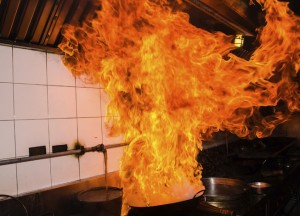
I am surprised to have been invited to this event, as I cannot actually cook.
In my university days this is what happened when I introduced cold water into boiling fat in an attempt to make some potato chips.
I will therefore be only talking about ambience and architecture.
LIONS

Food of course is primarily food.
Whilst I love eating it, and have been doing so for a number of decades, I still don’t understand all its complexities.
Once at lunch at a well known Wellington establishment, I asked the waitress what the fish of the day was? ‘Butterfish’ she answered.’ A good choice sir; it’s a vegetarian fish’ .
After thinking this through I said when she returned ‘ but isn’t little lambie and little bamby vegetarian animals?’. ‘that’s completely different’ she said.
HYENAE

You can see nose to tail eating is not a new thing.
Nature abhors waste.
There are, in these Serengeti scenes , a primitive ambiance, but it was only when dining began to occur indoors, that architecture became a factor in the culinary experience.
LAST SUPPER

Desmond Morris, the famous anthropologist regards the ritual of eating in a group to be an abstraction of the kill.
However humans, being aware of their own mortality, introduced hygiene, cutlery and cooking itself.
Also, unlike animals, the places in which human eating and drinking occurs, are important to us.
Generally place implies the existence of an interior ,but there are some exceptions.
SOUNDS OF SILENCE
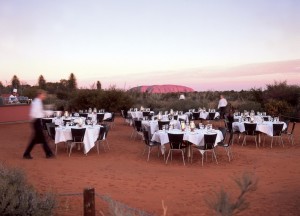
This is the ‘Sounds of Silence’ dinner at Uluru.
Having had this experience recently, the presence of the sun setting on Ayers rock and the panoply of the universe above does indeed justify removing the walls and the roof.
FOOD TRUCK
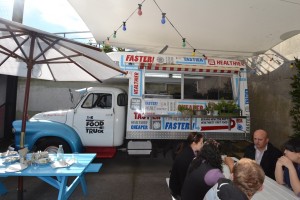
Mongolian society, which at one stage roamed over all of what is now Asia and Europe, left no memorable cuisine , in my view because their nomadic lifestyle ( is that a word ) did not allow it.
Nowadays we have mobile food in the form of food trucks, coffee outlets and Pie Carts.
They provide convenient food devoid of authenticity.
I personally hope to delay meals on wheels for as long as possible.
BOATHOUSE
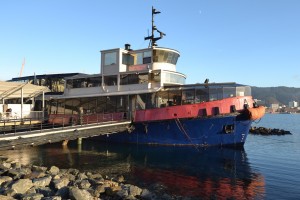
Then we have the perversion of the romance of sea travel, without the seasickness, in a boat going nowhere.
An old Bedford truck and a rusting tug are not architecture.
Wheels, though I love them, are not tied to place and therefore in my thesis, can’t provide a quality experience.
MCDONALDS
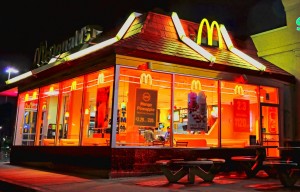
The Americans being food descendants of the Mongols, and prevailing over a similarly large land mass, extended the notion of ‘food on the run’.
The first McDonalds were placed at suburban edges and read as ‘our house’ not far from your house. The seduction of predictability and consistency without either shopping or talking to a chef.
Architecture is debased as the pimp of the fast food industry.
FAST FOOD
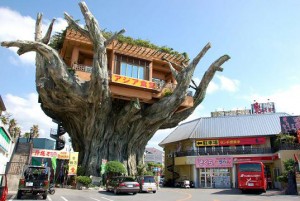
Wikipedia lists 312 fast food chains in the US alone.
Their points of difference use architecture and graphics as signage to lure their customers.
Perverse indeed.
Scientists are now even working on producing synthetic meat to complete the artificiality of the fast food experience.
CREAM CAN
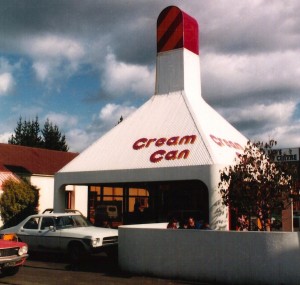
I have to admit that as an architectural business, we also got caught up in this brand business, but at least it was only ice cream.
We had an opportunity with the Cream Can chain to gently subvert the genre.
After the Hamilton, Tauranga and Hamilton branches closed, the upside down ice cream image was adapted for real estate and accountants offices.
No jokes please.
ROBATAYA
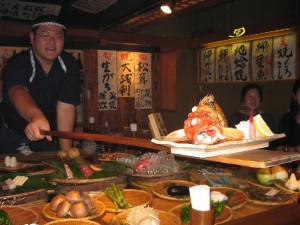
I have to admit that my personal joy is an enthusiastic chef cooking and serving me delicious fresh food in an intimate space.
Robataya in Tokyo.
I am now getting to the guts of my thesis , that cuisine, place and architecture need to all be present and balanced properly to define a memorable eating or drinking experience.
MADONNA INN. St Louis Obispo. Calif
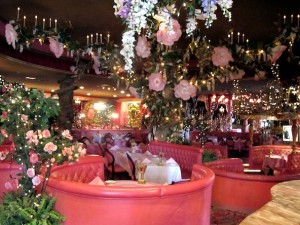
Achieving the balance is interesting.
Here is one extreme of the architecture dominating the food
The interior is so overcooked, so to speak, that it is difficult to find the actual meal, and I wouldn’t touch any fruit lest it be plastic.
NOMA
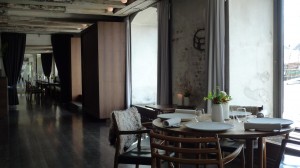
At the other extreme is the raw interior of what is said to be the world’s best restaurant.
Its minimalism to me is just as unbalanced as the Madonna Inn’s excess.
Chef Rene Redpezi ‘s food is cutting edge modern.
Not even a norivirus outbreak that made 63 diners ill in February 2013 affected Noma’s reputation,
as the gastronomical equivalent of ‘The Game of Thrones’
CUPBOARD KITCHEN / OPEN PLAN
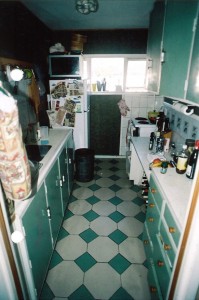
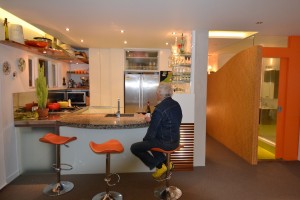
Domestically, the right balance has come a very long way.
Kitchens used to be claustrophobic and socially segregated food storage and production ‘cupboards’ with only a tenuous relationship with the dining table.
The embarrassment of guest seeing dirty dishes is now gone, along with the barriers between the preparation and the consumption of the food.
The cook and the diners can interact.
Bringing the kitchen into the dining space has been a boon for architects and designers as it has to look good, in fact really good is better.
Legions of Designer magazines feature ‘kitchen porn’ in which all the new surfaces, lighting and appliances are explored in high design.
Our increasing food discernment and knowledge has made Desmond Morris’s abstraction of the kill very civilised indeed.
COMMUNITY EATING
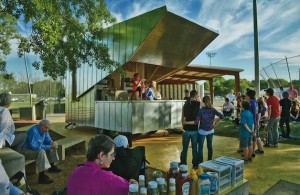
Architecture is also jumping into community eating.
This is a food stall ( note no wheels ) in Alabama where through the common need to eat, it acts as catalyst to community interaction and social cohesion.
The architects explain that the design stand is inspired by a Lions mouth. ( You see the primordial image is never very far away )
THE GROUNDS: ALEXANDRIA. SYDNEY
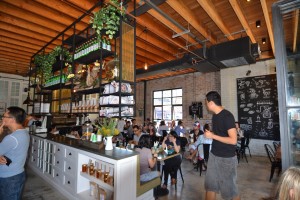
As chefs reach for local ingredients in their craft focussed cooking, designers are creating a new authenticity in the spaces.
This movement is sometimes called ‘depot dining’ where the honest expression of the materials and elements of the surroundings are in harmony with the ingredients.
A really good use for redundant warehouse and industrial spaces in our cities.
LITTLE HUNTER
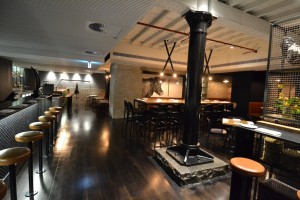
This ‘craft cooking’ is becoming very sophisticated.
This is Little Hunter in Melbourne. The Chef is ex Hester Blumenthal ‘The Fat Duck’.
Its entrance ,the opposite of fast food ‘in your face’ design, is discrete and personalised.
Part of the architecture, I believe, is acoustics. A balance should be found between too quiet or ‘dead ‘( sound absorbant wall and floor surfaces )where everyone in the restaurant can hear conversation, and too noisy ( reverberant hard surfaces ).
Too me, buzzy good, is where you can hear conversation at your table but not the adjoining one.
DESTINATION EXPERIENCES
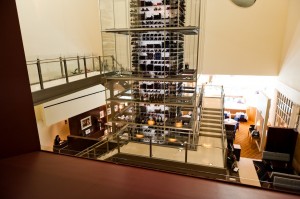
Not everything has to be rustic cozy. There is always a place for the special experience.
This is Aureole’s, in Las Vegas ( of course) Wine Tower where the wine waiters abseil down three stories to bring your drop to your table.
COVER OF ARCH RECORD
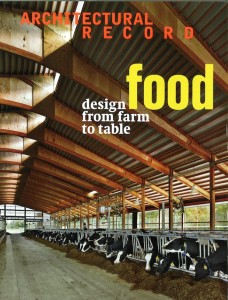
This last image is where my thesis reaches its full apogee. This recent magazine claims that animals themselves benefit from high design habitats.
Chickens lay more eggs, and cows produce more milk in architectural coops and milking sheds.
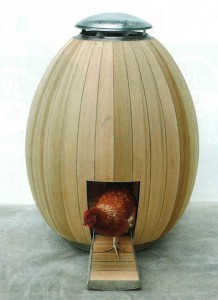
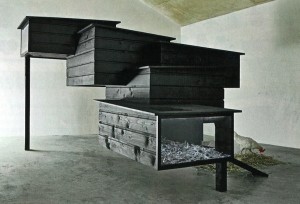
If this can happen to animals, imagine how human diners and drinkers could similarly eat and drink more, and stay longer in our high design bars, cafes and restaurants.
Now that we have ‘software architecture’ the time is right to introduce the term ‘food architecture’
If that happened I would feel so much better about setting fire to kitchens
